Excerpts from Jim Conrad's
Naturalist Newsletter
entry dated August 30, 2022, issued from near Tequisquiapan, elevation about 1,900m (6200 ft), N20.565°, W99.890°, Querétaro state, MÉXICO
"MEXICAN" SMARTWEED
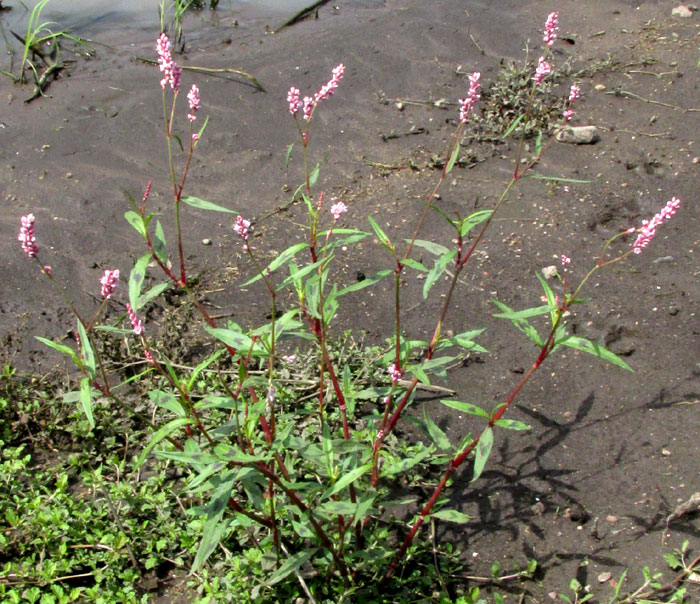
At the muddy edge of the village's little reservoir, the above smartweed was flowering. With its fingerlike heads composed of small, pinkish flowers, smartweeds are such distinctive, worldwide-distributed and commonly occurring species that you don't need to "do the botany" to identify them as a group -- as smartweeds. Smartweeds are indisputably members of the Buckwheat Family, the Polygonaceae. However, within that family, taxonomy still is in a confused mess, and to settle on a name for a given smartweed, you still have to do the botany.
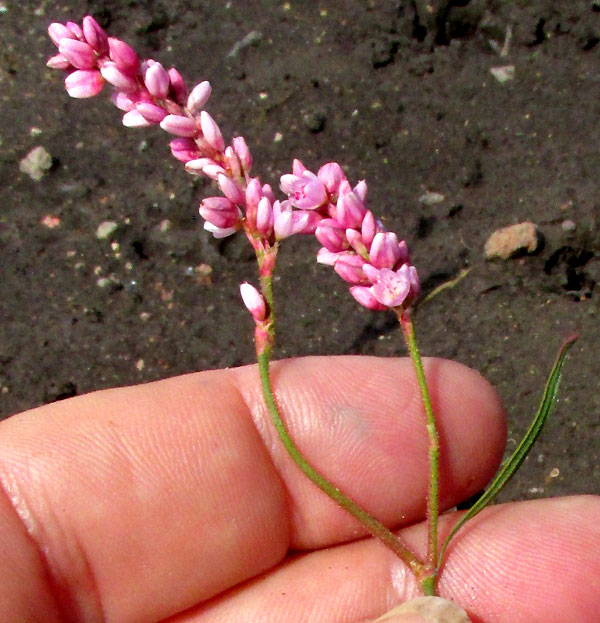
Most smartweed flowering heads I've seen are pinkish, though some white-flowered species do turn up. Sometimes the heads are long and droopy, but our plant's are relatively short and erect. The heads are composed of small, cuplike flowers:
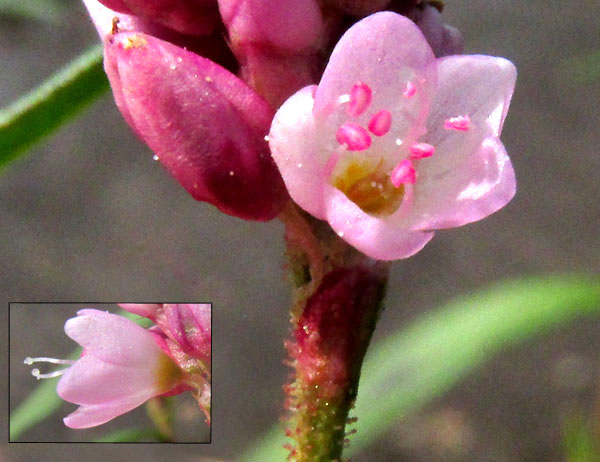
The above close-up shows a flower with six stamens surrounding a hardly visible divided style, the two slender arms of which are clearly visible in the inset at the lower left, each arm tipped with a tiny roundish stigma. The inset also shows that the pink corolla lobes at their bases turn green, with no sign of a calyx. Smartweeds flowers don't form separate corollas and calyxes. Instead, one speaks of a perianth comprising separate tepals, the term tepals used when there's no clear difference between corolla lobes and calyx sepals. Another feature to notice in the above picture is that the stem below the flowering head, the peduncle, is covered with sticky, gland-tipped hairs, nicely situated to dissuade critters from climbing up the stem and eating the flowers. That's an important fieldmark for this species.
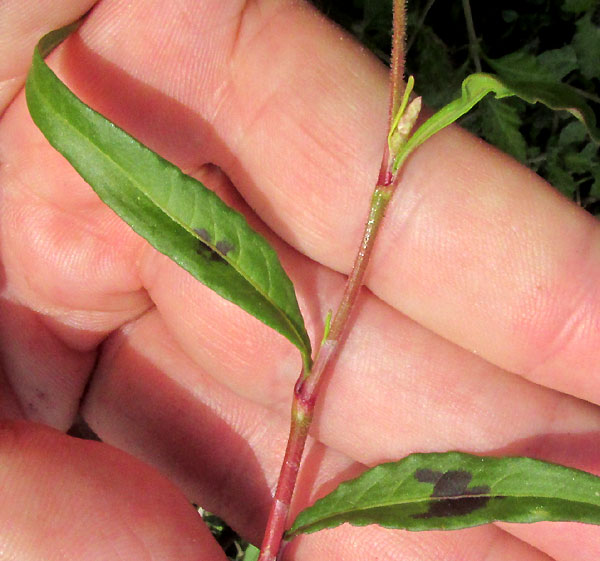
This species' leaves are smallish and bear few if any hairs. Sometimes they bear nice dark splotches as shown. All smartweeds produce curious silvery cylinders around their stems, where leaves attach to the stems, as seen in the above picture. A close-up of this curiosity is shown below:
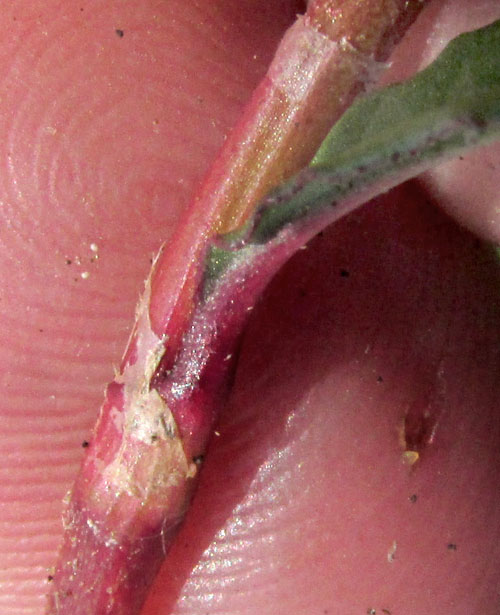
The tissue of the silvery cylinders is like fragile cellophane or very thin paper. The structures are referred to as ocreae. With age, often the ocrea disintegrates, for its main service is to wrap around emerging leaves and sprouts, to protect them from weather extremes. Sometimes ocreae are called stipular sheathes. Ocreae can bear needlelike spines atop them, or be hairy, or display any number of other features, so for smartweed species identification they're worth noticing.
Smartweed species mainly occur in the northern Temperate Zone. However, our upland, central Mexican area is habitually cool like the warmer, semiarid parts of the Temperate Zone, so seven species are documented for our central Mexican Bajío region. In this area, if you're a smartweed with relatively short, somewhat stiff, spikelike heads beneath which the peduncles are covered with short, gland-tipped hairs, and the flowers produce six to eight stamens, not five, you know which of several smartweed species you have.
However... the authoritative Flora del Bajío names it Polygonum mexicanum, which the authoritative World Flora Online is OK with, but the authoritative Kew Gardens Plants of the World Online regards that name as an outdated synonym of Persicaria segetum, and the authoritative Flora of North America probably would agree with that, since they've dumped most but not all the taxa they used to say were Polygonum species into the genus Persicaria. However, the Flora of North America adds in its notes for the Buckwheat Family that "Generic limits have been much debated, particularly the circumscription of Polygonum in the broad sense."
My sense is that the overall world trend is in favor of the splitter-offers, but that -- especially with the smartweeds -- really no one knows what, despite all the gazing at long computer readouts of gene sequences, our plant will end up being called. Now in 2022 I'm filing our plant under the name of PERSICARIA SEGETUM. Since a goodly number of folks still call it Polygonum mexicanum, in English it can be called the "Mexican" Smartweed, "Mexican" with quotation marks since no one else seems to call it that, and its distribution is not only from northern Mexico to the southern border, but also -- at least if it's recognized as Persicaria segetum -- into northern South America.
The online Biblioteca Digital de la Medicina Tradicional Mexicana, which calls our plant Chilillo, or "little chili pepper," maybe because of the short, pink flowering head, reports that traditionally the plants were used for "aljorra, chincual o chincuale," for which the ground plant is spread on the affected parts. Aljorra I find described, weirdly, as a bruising of nails, lips and eyelids, as well as seizures. Chincual, or chincuale, is described as a rash on the thighs and around the anus of newborn boys.
About the name "smartweed." It's "smart" in the sense that a somewhat outdated use of "smart" is to refer to a sharp pain, as in "That smarts!" The Oxford English Dictionary explains that the word "smartweed" derives from an older word, arsesmart, as in the British "smarts the arse." A quotation from 1617 using the word arsesmart is "... because if it touch the taile or other bare skinne, it maketh it smart, as often it doth, being laid into the bed greene to kill fleas."
Someone in the etymology section of Reddit.Com posted notes on an even earlier name for smartweed, which was culrage. That's Old French, constructed of the words cul, meaning "ass," and rage, meaning "rabies."
Well, you find a weed at the reservoir, one thing leads to another.